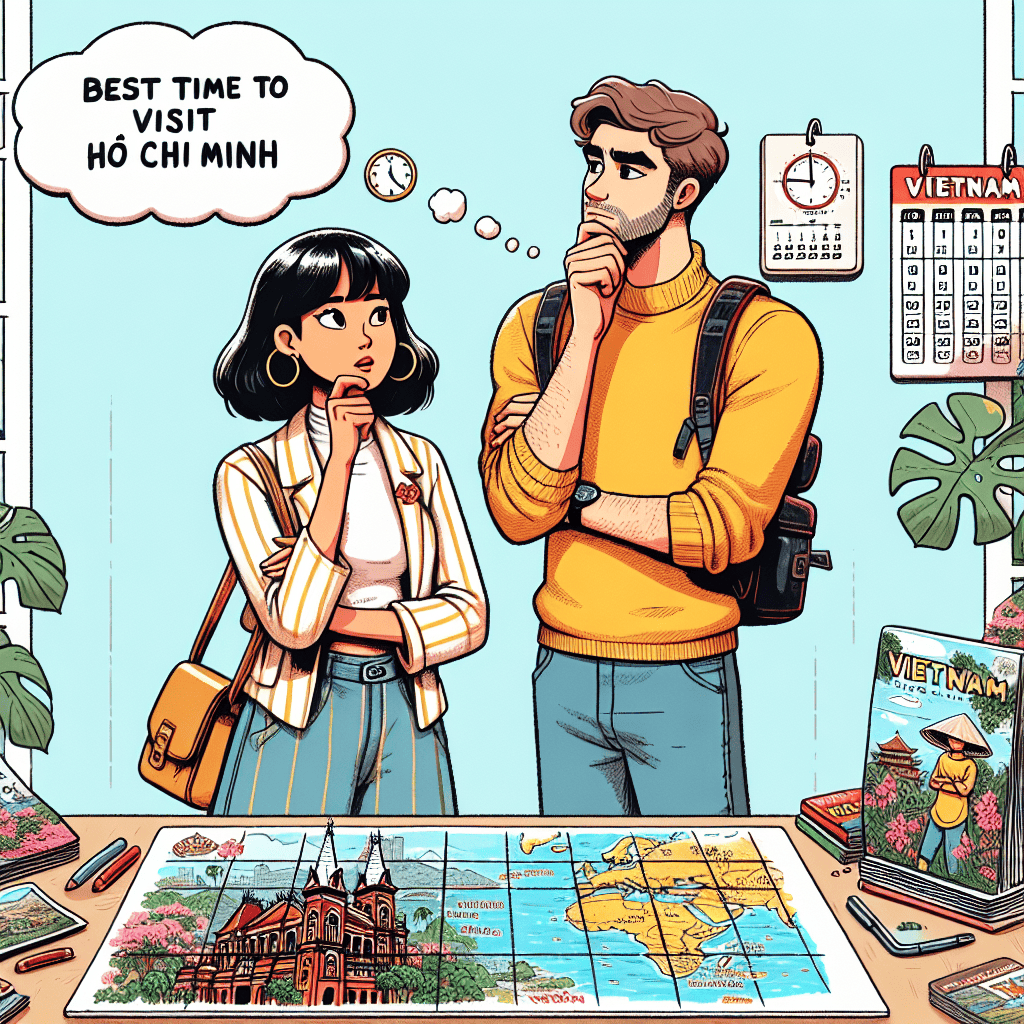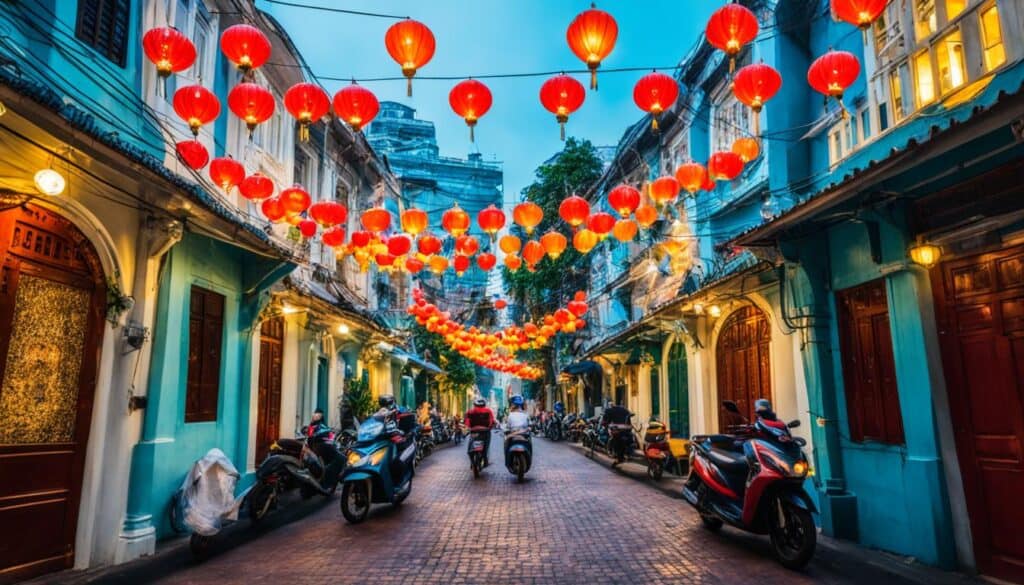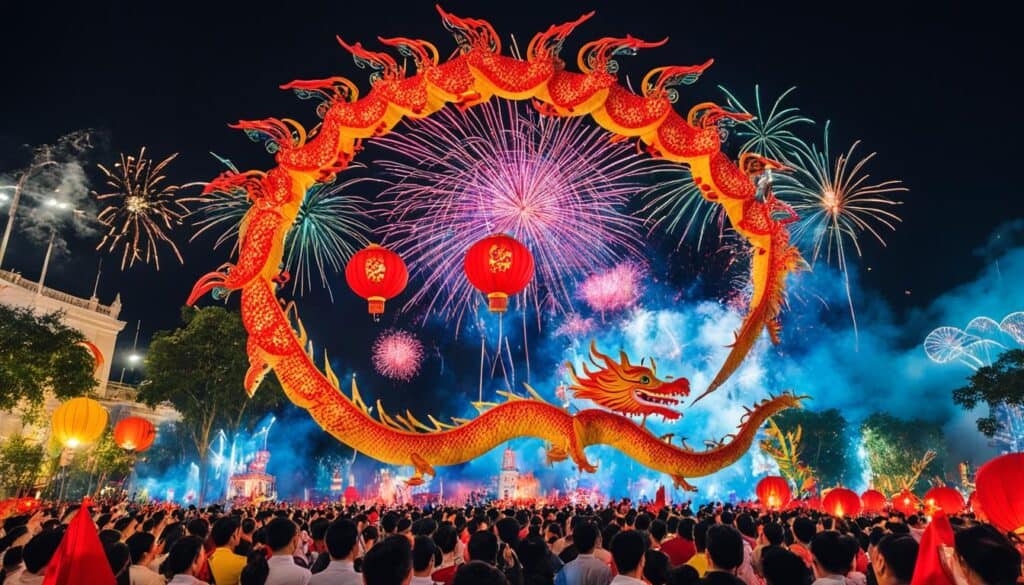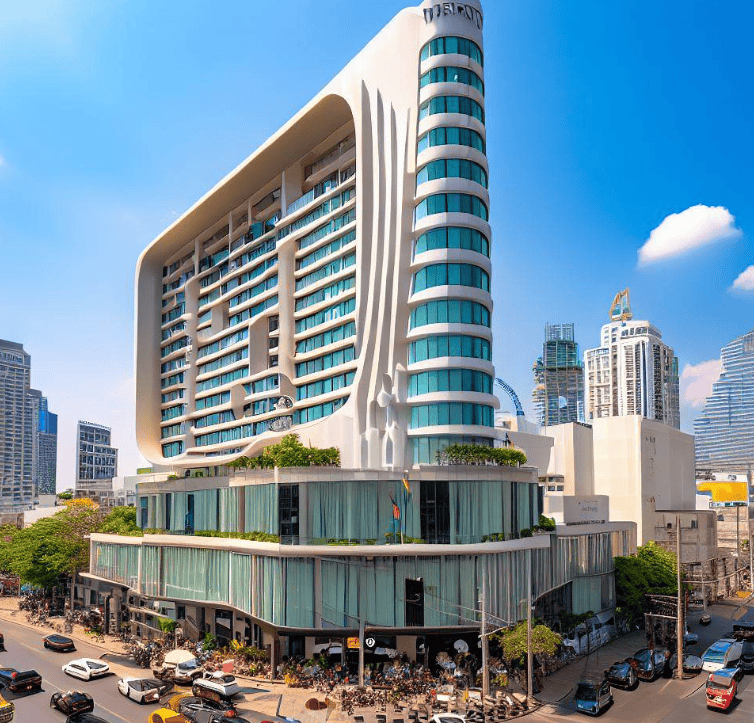
Have you ever dreamed of sipping fragrant Vietnamese coffee while watching the vibrant streets of Ho Chi Minh City come to life?
Or perhaps you’ve imagined yourself haggling in the bustling Ben Thanh Market, surrounded by a kaleidoscope of sights, sounds, and smells?
Well, you’re not alone!
In 2023, a staggering 30 million international visitors flocked to Ho Chi Minh City, each hoping to experience its unique blend of history, culture, and modernity.
But here’s the million-dong question: When is the best time to visit Ho Chi Minh City?
As someone who’s witnessed countless sunrises over the Saigon River and navigated through monsoon-drenched streets, I can tell you that timing is everything in this city of contrasts.
Can you imagine saving up for months, maybe even years, for your dream trip to Vietnam. You step off the plane, ready to explore… only to find yourself caught in a torrential downpour or sweltering in unbearable humidity. Not exactly the vacation you envisioned, right?
That’s why choosing the right time to visit Ho Chi Minh City can make or break your experience. But don’t worry – whether you’re a history buff eager to explore war museums, a foodie ready to slurp your way through steaming bowls of pho, or an adventure seeker looking to use the city as a launchpad for exploring the Mekong Delta, there’s a perfect time for you to visit.
So, are you ready to uncover the secrets of when to experience Ho Chi Minh City at its finest? Buckle up (or should I say, hop on your motorbike) as we embark on a journey through the seasons, festivals, and hidden gems of this captivating city. Trust me, by the end of this guide, you’ll be planning your trip with the confidence of a seasoned Saigon explorer!
Climate Overview of Ho Chi Minh City
Tropical Monsoon Climate
Ho Chi Minh City’s climate might surprise you if you’re not prepared. Imagine stepping off the plane and feeling like you’ve walked into a warm, humid embrace – that’s the tropical monsoon climate for you! This unique weather pattern shapes the city’s rhythm and influences everything from local cuisine to daily activities.
The city experiences high temperatures and humidity year-round, with average temperatures hovering between 25°C (77°F) and 35°C (95°F). Don’t let these numbers fool you, though. The humidity can make it feel much warmer, especially if you’re not used to tropical climates. Pro tip: always carry a bottle of water and a small towel – you’ll thank me later!
Interestingly, this climate has played a significant role in shaping Vietnamese culture. Have you ever wondered why so many locals wear conical hats (nón lá) or why you’ll find countless street-side sugarcane juice stands? It’s all about staying cool in this tropical heat!
Two Distinct Seasons
Unlike the four seasons you might be used to, Ho Chi Minh City dances to the rhythm of two main seasons: the dry season and the wet season. This dichotomy creates a fascinating ebb and flow to city life that you’ll want to experience.
Dry Season:
- Months: December to April
- Average Temperature: 28°C (82°F)
- Rainfall: Minimal
- Humidity: Lower (but still high by many standards)
Wet Season:
- Months: May to November
- Average Temperature: 30°C (86°F)
- Rainfall: Heavy, often daily afternoon showers
- Humidity: Very high
A handy table to help you visualize the seasonal differences:
[su_table]
| Season | Months | Avg. Temp | Rainfall | Humidity |
|---|---|---|---|---|
| Dry | Dec-Apr | 28°C (82°F) | Minimal | Lower |
| Wet | May-Nov | 30°C (86°F) | Heavy | Very high |
[/su_table]
Each season brings its charm to the city. During the dry season, you’ll find locals and tourists alike enjoying outdoor cafes and street food stalls late into the evening. The wet season, on the other hand, transforms the city with its dramatic afternoon downpours, creating a perfect excuse to duck into a cozy cafe and enjoy a cup of ca phe sua da (Vietnamese iced coffee).
Did you know that the wet season coincides with the ripening of many tropical fruits? If you visit during this time, you’re in for a treat! Keep an eye out for street vendors selling mangosteen, rambutan, and the infamous durian. Just remember, if you try durian, don’t bring it back to your hotel – many places ban this pungent fruit!
Understanding these seasonal patterns will help you pack appropriately and plan your activities. Whether you’re exploring the Cu Chi tunnels or navigating the streets of District 1, knowing what to expect from the weather will ensure you make the most of your visit to this vibrant city.
Ideal Months for Pleasant Weather
December to April: The Dry Season
If you’re looking for the most comfortable weather to explore Ho Chi Minh City, set your sights on the dry season, particularly from December to April. During these months, you’ll experience lower humidity and minimal rainfall, making it perfect for outdoor adventures and sightseeing.
December marks the beginning of this golden period, with temperatures cooling down to a pleasant average of 26°C (79°F). You’ll notice a palpable excitement in the air as locals and tourists alike revel in the comfortable climate. It’s an ideal time to explore the city’s many outdoor markets, like the sprawling Binh Tay Market in Chinatown, without breaking a sweat.
As you move into January and February, you’ll encounter the coolest temperatures of the year. Don’t be surprised if you see locals bundled up in light jackets while you’re still comfortable in a t-shirt! This is also when you’ll find the city at its most festive, with Tet (Vietnamese New Year) celebrations in full swing. The streets come alive with colorful decorations, flower markets, and the intoxicating scent of traditional foods.
Best Months: December to February
While the entire dry season offers pleasant weather, December to February stands out as the cream of the crop. These months combine the best of everything: comfortable temperatures, low humidity, and minimal rainfall.
Here’s a quick breakdown of what you can expect during these prime months:
[su_table]
| Month | Avg. Temp (°C/°F) | Rainfall (mm) | Humidity (%) |
|---|---|---|---|
| December | 26°C / 79°F | 48 | 73 |
| January | 26°C / 79°F | 14 | 72 |
| February | 27°C / 81°F | 4 | 70 |
[/su_table]
February, in particular, is a gem. With an average of only 4mm of rainfall, it’s the driest month of the year. This makes it perfect for exploring outdoor attractions like the Cu Chi Tunnels or taking a day trip to the Mekong Delta without worrying about sudden downpours.
Remember, though, that this is also peak tourist season. You’ll need to book accommodations and popular tours in advance. But the trade-off is worth it – imagine sipping a cold Saigon beer on a rooftop bar, enjoying the cool evening breeze as you watch the sun set over the city skyline. Pure magic!
Shoulder Months: March and April
As we move into March and April, we enter what I like to call the “shoulder season.” The weather is still dry, but temperatures start to climb, offering a preview of the heat to come in the wet season.
March sees average temperatures of around 28°C (82°F), while April can reach up to 29°C (84°F). Humidity also begins to creep up, but it’s still manageable, especially if you plan your activities wisely. These months offer a great balance – you’ll avoid the peak tourist crowds of December to February, but still enjoy relatively comfortable weather.
One of the best things about visiting during these months is the abundance of tropical fruits. Keep an eye out for street vendors selling ripe mangoes and luscious dragon fruit. April also marks the beginning of the durian season – if you’re brave enough to try this infamous “king of fruits,” now’s your chance!
Pro tip: During these warmer months, embrace the local custom of “siesta.” Many businesses close between 12 pm and 2 pm, and for good reason. Use this time to retreat to your air-conditioned hotel room or find a shady spot in one of the city’s parks, like Tao Dan Park. Then, reemerge in the late afternoon when the heat subsides to continue your explorations.
Remember, regardless of when you visit, Ho Chi Minh City’s weather can be unpredictable. Always carry a small umbrella or rain jacket, just in case. And don’t forget to stay hydrated – the tropical climate can sneak up on you if you’re not careful. But with a little preparation, you’ll be ready to enjoy all the wonders this vibrant city has to offer, come rain or shine!
IV. Visiting During Different Seasons
Visiting Ho Chi Minh City in the Dry Season
Advantages of Visiting in the Dry Season
The dry season in Ho Chi Minh City, spanning from December to April, offers a plethora of advantages for visitors. First and foremost, you’ll enjoy clear, sunny skies most days, perfect for exploring the city’s outdoor attractions. Imagine strolling through the wide boulevards of District 1, admiring the French colonial architecture without a cloud in sight. The iconic Saigon Central Post Office and Notre-Dame Cathedral Basilica of Saigon look even more stunning against a backdrop of blue skies.
During this time, you can fully immerse yourself in the city’s vibrant street life. The dry weather encourages locals to spill out onto the sidewalks, creating a lively atmosphere. You’ll find makeshift cafes on every corner, serving strong Vietnamese coffee and bánh mì (Vietnamese sandwiches). Don’t miss the chance to join the locals for a street-side meal – it’s an essential Ho Chi Minh City experience!
The dry season also coincides with some of Vietnam’s most important festivals. Tet, the Vietnamese New Year, usually falls in late January or early February. During this time, the city transforms with colorful decorations, flower markets, and traditional performances. It’s a unique opportunity to witness Vietnamese culture at its most vibrant and festive.
Potential Drawbacks
While the dry season offers many advantages, it’s important to be aware of potential drawbacks. The most significant is the influx of tourists. December to February marks the peak tourist season, which means popular attractions can get crowded. You might find yourself jostling for space at sites like the War Remnants Museum or the Reunification Palace.
Here’s a quick look at tourist numbers during the dry season:
[su_table]
| Month | Estimated Tourist Numbers |
|---|---|
| December | High |
| January | Very High (Tet) |
| February | High |
| March | Moderate |
| April | Moderate |
[/su_table]
Another consideration is the gradual increase in temperature as the dry season progresses. While December and January are pleasantly cool, March and April can be quite hot, with temperatures sometimes reaching 35°C (95°F). If you’re not accustomed to tropical heat, you might find sightseeing challenging during the hottest parts of the day.
Lastly, the dry season coincides with peak prices for accommodations and flights. You’ll need to book well in advance and be prepared to pay premium rates, especially around Tet. However, many visitors find the experience worth the extra cost.
Visiting Ho Chi Minh City in the Wet Season
Advantages of Visiting in the Wet Season
Don’t let the term “wet season” deter you – visiting Ho Chi Minh City from May to November has its own unique charm. One of the biggest advantages is the smaller crowds. You’ll have more breathing room at popular attractions and might even snag some great deals on accommodations and tours.
The wet season brings lush greenery to the city and its surroundings. Parks like Tao Dan and the Botanical Gardens burst into life, offering a refreshing escape from the urban hustle. If you’re a photography enthusiast, the dramatic skies and reflections after a rain shower can provide stunning photo opportunities.
This season also coincides with some interesting cultural events. The Mid-Autumn Festival, usually in September or October, fills the streets with colorful lanterns and the aroma of mooncakes. It’s a magical time to experience Vietnamese traditions firsthand.
Challenges to Consider
The most obvious challenge of the wet season is, well, the rain. Expect short but intense downpours, typically in the afternoon. These can disrupt outdoor plans and make navigating the city’s streets a bit tricky. However, the rain is often predictable, allowing you to plan your day around it.
A breakdown of average rainfall during the wet season:
[su_table]
| Month | Average Rainfall (mm) |
|---|---|
| May | 218 |
| June | 311 |
| July | 294 |
| August | 270 |
| September | 340 |
| October | 268 |
[/su_table]
The humidity during the wet season can be quite high, often reaching 80-90%. This can make the heat feel more intense, even though actual temperatures aren’t much higher than in the dry season. You’ll want to pace yourself, stay hydrated, and take advantage of air-conditioned spaces when needed.
Flooding can occasionally occur in some parts of the city, particularly during heavy rains. While the city’s infrastructure has improved in recent years, some streets may become temporarily impassable. It’s a good idea to check local weather reports and plan your routes accordingly.
Despite these challenges, many visitors find the wet season adds a unique dimension to their Ho Chi Minh City experience. The sudden downpours create a rhythm to city life, with locals expertly navigating the weather. You’ll see streets suddenly fill with colorful ponchos and the pitter-patter of rain on awnings creates a soothing soundtrack to your Vietnamese coffee.
Making the Most of Your Visit, Rain or Shine
Regardless of when you choose to visit Ho Chi Minh City, there are ways to make the most of your trip. In the dry season, start your days early to avoid the midday heat. Take advantage of the clear evenings to enjoy rooftop bars and outdoor night markets like Bui Vien Walking Street.
During the wet season, embrace the local lifestyle. Carry a lightweight raincoat or umbrella, and don’t let a little rain dampen your spirits. Use sudden downpours as an opportunity to duck into a local cafe or museum. The HCMC Museum of Fine Arts or the quirky Apartment Cafe in District 3 are perfect rainy day hideouts.

Remember, Ho Chi Minh City is a year-round destination with something to offer in every season. Here’s a quick comparison to help you decide:
[su_table]
| Season | Pros | Cons |
|---|---|---|
| Dry (Dec-Apr) | Clear skies, festive atmosphere, comfortable temperatures | Crowded, higher prices |
| Wet (May-Nov) | Fewer tourists, lush scenery, cultural festivals | Frequent rain, high humidity |
[/su_table]
Whether you prefer the clear skies and festive atmosphere of the dry season or the lush greenery and smaller crowds of the wet season, Ho Chi Minh City will captivate you with its energy, history, and incredible food. Just remember to pack your sense of adventure along with your weather-appropriate gear!
Best Time to Visit Based on Events and Festivals
Major Events and Festivals in Ho Chi Minh City
Tet (Vietnamese New Year): January/February
Tet, or Vietnamese New Year, is the most significant celebration in Vietnam, and experiencing it in Ho Chi Minh City is truly unforgettable. The exact dates vary each year, falling between late January and mid-February, based on the lunar calendar. During this time, the city transforms into a vibrant spectacle of colors, lights, and festivities.
In the weeks leading up to Tet, you’ll notice an infectious buzz of excitement in the air. Streets become adorned with red and gold decorations, symbolizing luck and prosperity. The flower markets, especially the famous one on Nguyen Hue Walking Street, burst into a riot of colors. Here, you’ll find locals carefully selecting yellow mai (ochna integerrima) and pink peach blossoms to decorate their homes.
During Tet itself, many businesses close as families gather to celebrate. However, this creates a unique atmosphere for visitors. The usually bustling streets become eerily quiet, offering a rare glimpse of a peaceful Ho Chi Minh City. Don’t miss the spectacular fireworks display on New Year’s Eve, best viewed from the Saigon River or one of the city’s many rooftop bars.
Mid-Autumn Festival: September/October
The Mid-Autumn Festival, locally known as “Tết Trung Thu,” is a magical time in Ho Chi Minh City, especially if you’re traveling with children. This lunar harvest festival usually falls in September or October and celebrates family reunions and the fullest moon of the year.
During this festival, the streets come alive with the glow of colorful lanterns and the laughter of children. You’ll see groups of kids parading through neighborhoods, carrying star-shaped lanterns and performing lion dances. It’s a heartwarming sight that captures the essence of Vietnamese community spirit.
One of the festival’s highlights is the abundance of mooncakes. These traditional pastries come in various flavors, from classic lotus seed paste to more modern variations like green tea or durian. Many hotels and bakeries offer special mooncake gift sets, which make for unique souvenirs. For an authentic experience, head to Cho Lon (Chinatown) in District 5, where you can watch skilled artisans hand-making mooncakes.
Other Notable Events Throughout the Year
Ho Chi Minh City hosts a variety of events and festivals throughout the year, each offering a unique glimpse into Vietnamese culture. Here’s a table of some notable events:
[su_table]
| Month | Event | Description |
|---|---|---|
| April | Hung Kings Commemoration Day | A patriotic celebration honoring the legendary founders of Vietnam |
| April/May | Reunification Day & Labor Day | Back-to-back holidays with parades and fireworks |
| September | Vietnam National Day | Patriotic celebrations with flags and parades |
| December | Christmas | While not traditionally Vietnamese, HCMC embraces the festive spirit with decorations and markets |
[/su_table]
One event that often flies under the tourist radar is the Vu Lan Festival, or Ghost Festival, in August. This Buddhist event honors ancestors and deceased loved ones. You’ll see locals releasing paper lanterns on the Saigon River and leaving offerings at temples. It’s a poignant and beautiful cultural experience.
For food enthusiasts, keep an eye out for the various food festivals that pop up throughout the year. The Street Food Festival in District 1 (usually in April) is a gastronomic delight, showcasing the best of Vietnamese street cuisine. You can sample everything from bánh xèo (crispy pancakes) to bò lá lốt (beef wrapped in betel leaves) in one bustling location.
Music lovers should consider timing their visit with the Monsoon Music Festival in November. This international music festival brings together local and international artists for a weekend of eclectic performances. It’s a great way to experience Vietnam’s growing music scene and mingle with locals.
Remember, while these events can greatly enhance your visit, they can also mean larger crowds and higher prices. Book accommodations well in advance if you plan to visit during major festivals like Tet. However, the unique cultural experiences these events offer often outweigh any inconveniences. Whether you’re releasing a lantern during the Mid-Autumn Festival or joining in the Tet celebrations, these events will leave you with unforgettable memories of Ho Chi Minh City.
For history buffs, April 30th marks Reunification Day, commemorating the end of the Vietnam War. The city hosts parades and events, and many museums offer special exhibitions. It’s a somber yet enlightening time to visit, offering deep insights into Vietnam’s complex history.
If you’re interested in contemporary Vietnamese culture, plan your visit around the Ho Chi Minh City International Film Festival, usually held in December. This event showcases both local and international films, providing a window into Vietnam’s burgeoning film industry.
Here’s a quick guide to help you plan:
[su_table]
| Season | Key Events | Atmosphere |
|---|---|---|
| Spring (Feb-Apr) | Tet, Street Food Festival | Festive, busy |
| Summer (May-Jul) | Southern Fruit Festival | Hot, lively |
| Autumn (Aug-Oct) | Mid-Autumn Festival, Vu Lan | Cultural, spiritual |
| Winter (Nov-Jan) | Christmas, New Year’s Eve | Cooler, celebratory |
[/su_table]
Each event offers a unique perspective on Vietnamese culture. From the solemnity of Vu Lan to the jubilance of Tet, these celebrations will enrich your understanding of Vietnam far beyond what you’ll find in any guidebook.

Best Time to Visit Based on Tourist Crowds
Peak Tourist Seasons
December to February
The period from December to February marks the high season for tourism in Ho Chi Minh City. This coincides with the dry season and several major holidays, creating a perfect storm of visitors. During these months, you’ll find the city buzzing with energy, but also teeming with tourists from all corners of the globe.
December kicks off the season with a surge of visitors escaping winter in their home countries. The city embraces a festive atmosphere, with Christmas decorations adorning shops and hotels, despite Christmas not being a traditional Vietnamese holiday. You’ll find charming Christmas markets popping up, like the one at 23/9 Park, offering a unique blend of Western and Vietnamese holiday cheer.
January and February see the peak of tourist activity, largely due to Tet (Vietnamese New Year). While Tet itself can be a magical time to experience Vietnamese culture, it comes with challenges for tourists. Many businesses close for the holiday, and prices for accommodations and flights skyrocket. However, if you plan ahead, you can witness spectacular fireworks displays, traditional lion dances, and flower markets bursting with color.
Here’s a quick look at what to expect during these peak months:
[su_table]
| Month | Tourist Density | Hotel Prices | Main Attractions |
|---|---|---|---|
| December | High | $$$ | Christmas markets, New Year’s Eve |
| January | Very High | $$$$ | Tet preparations, flower markets |
| February | Very High | $$$$ | Tet celebrations, fireworks |
[/su_table]
July and August
The months of July and August form a secondary peak season in Ho Chi Minh City. This surge aligns with summer holidays in many Western countries and school breaks in Vietnam. While not as crowded as the December-February period, you’ll still notice a significant increase in tourist numbers.
July brings the Southern Fruit Festival, a delightful event for food lovers. Held in Suối Tiên Theme Park, this festival showcases the incredible variety of tropical fruits grown in southern Vietnam. You can sample everything from familiar mangoes and pineapples to more exotic fruits like mangosteen and rambutan. It’s a fruit lover’s paradise and a great way to beat the summer heat.
August sees a mix of local and international tourists. Many Vietnamese families travel during this time, as it’s the last chance for a vacation before the school year starts. You might find popular attractions like the Cu Chi Tunnels or the War Remnants Museum more crowded than usual. However, this also means a livelier atmosphere in the city, with many outdoor events and activities.
Off-Peak Seasons
May to June
The months of May and June offer a sweet spot for visitors looking to avoid the crowds. This period falls between the dry and wet seasons, providing a unique blend of weather conditions and fewer tourists.
May marks the beginning of the wet season, but rainfall is still relatively light compared to later months. You’ll experience occasional afternoon showers, which can actually provide a refreshing break from the heat. These months offer a great opportunity to explore outdoor attractions like the Jade Emperor Pagoda or the Saigon Zoo and Botanical Gardens without the intense crowds of peak season.
June brings the Đà Lạt Flower Festival, which, although not in Ho Chi Minh City itself, is easily accessible and worth a side trip. Đà Lạt, known as the “City of Eternal Spring,” is just a short flight or bus ride away. The festival showcases Vietnam’s flower industry with stunning displays and parades. It’s a photographer’s dream and a great excuse to escape the city heat for a few days.
Snapshot of these off-peak months:
[su_table]
| Month | Tourist Density | Hotel Prices | Weather | Main Attractions |
|---|---|---|---|---|
| May | Low | $$ | Warm, occasional rain | Labor Day celebrations |
| June | Low | $$ | Warm, increasing rain | Đà Lạt Flower Festival |
[/su_table]
September to November
The period from September to November offers another excellent opportunity for those seeking a less crowded Ho Chi Minh City experience. These months mark the tail end of the wet season, bringing gradually decreasing rainfall and more comfortable temperatures.
September is a particularly interesting time to visit. The Mid-Autumn Festival, usually falling in this month, transforms the city into a wonderland of lanterns and mooncakes. You’ll see children parading through the streets with colorful lanterns, and bakeries competing to create the most elaborate mooncake designs. It’s a magical time that offers insight into Vietnamese family traditions and folklore.
October and November bring increasingly pleasant weather, with temperatures cooling slightly and rainfall becoming less frequent. This makes it an ideal time for outdoor exploration. Consider taking a day trip to the Cu Chi Tunnels or exploring the Mekong Delta without the sweltering heat of earlier months. The reduced tourist numbers mean you can enjoy these experiences at a more relaxed pace.
Here’s what you can expect during these months:
[su_table]
| Month | Tourist Density | Hotel Prices | Weather | Main Attractions |
|---|---|---|---|---|
| September | Moderate | $$ | Warm, frequent rain | Mid-Autumn Festival |
| October | Low | $$ | Warm, decreasing rain | Halloween events |
| November | Low | $$ | Pleasant, occasional rain | Monsoon Music Festival |
[/su_table]
During these off-peak months, you’ll find it easier to snag reservations at popular restaurants and rooftop bars. Don’t miss the opportunity to dine at trendy spots like Anan Saigon or Qui Cuisine Mixology without the long wait times of peak season.
Remember, “off-peak” doesn’t mean “not worth visiting.” In fact, these periods often offer the most authentic experiences. You’ll have more opportunities to interact with locals, stumble upon hidden gems, and experience the city at a more relaxed pace. Whether you’re haggling at Ben Thanh Market or sipping coffee in a hidden alley cafe, you’ll find the essence of Ho Chi Minh City shines just as brightly – if not more so – during these quieter months.
For the adventurous traveler, these off-peak times also present unique opportunities. With fewer tourists around, you might find yourself invited to a local wedding or family celebration. These spontaneous encounters often become the most cherished memories of a trip.
Ultimately, whether you choose to visit during peak or off-peak seasons depends on your travel style and priorities. But rest assured, Ho Chi Minh City’s vibrant energy, rich history, and incredible food scene remain constant year-round, ready to captivate you whenever you decide to visit.
VII. Best Time to Visit for Budget Travelers
When to Find the Best Deals
Accommodation Prices Throughout the Year
If you’re looking to stretch your dong (that’s Vietnamese currency, by the way) as far as possible, timing your visit to Ho Chi Minh City can make a big difference. Accommodation prices fluctuate significantly throughout the year, following the ebb and flow of tourist seasons.
The months of May, June, September, and October often offer the best value for money. These shoulder season months see fewer tourists, prompting many hotels and hostels to lower their rates to attract visitors. You might snag a room in a boutique hotel in District 1 for the price of a hostel bed during peak season. Keep an eye out for hidden gems like the charming alleyway guesthouses in District 3 – they often offer local experiences at unbeatable prices.
Rough guide to accommodation prices throughout the year:
[su_table]
| Month | Price Level | Notes |
|---|---|---|
| Jan-Feb | $$$$ | Tet holiday, peak season |
| Mar-Apr | $$$ | End of dry season |
| May-Jun | $$ | Start of wet season, great deals |
| Jul-Aug | $$$ | Summer holidays |
| Sep-Oct | $$ | End of wet season, bargain prices |
| Nov-Dec | $$$ | Start of dry season, prices rising |
[/su_table]
Even in expensive months, Ho Chi Minh City offers options for every budget. From luxurious five-star hotels to cozy homestays, you’ll find something that fits your wallet. Don’t shy away from local accommodations – a stay in a family-run guesthouse can offer invaluable cultural insights and often includes home-cooked breakfasts that beat any hotel buffet!
Flight Prices and Availability
Just like accommodation, flight prices to Ho Chi Minh City fluctuate throughout the year. Generally, you’ll find the best deals during the wet season, particularly in September and October. Airlines often lower their prices during these months to encourage tourism during the off-peak season.
Keep in mind that while September and October offer great flight deals, they also coincide with typhoon season in Southeast Asia. While Ho Chi Minh City doesn’t usually bear the brunt of these storms, they can affect flight schedules.
Always purchase travel insurance and be prepared for potential delays.
Here’s a general overview of flight trends:
[su_table]
| Month | Price Level | Availability | Notes |
|---|---|---|---|
| Jan-Feb | High | Limited | Tet holiday, book early |
| Mar-Apr | Medium | Good | Pleasant weather |
| May-Jun | Low | Excellent | Start of wet season |
| Jul-Aug | High | Limited | Summer holidays |
| Sep-Oct | Low | Excellent | Best deals, typhoon season |
| Nov-Dec | Medium | Good | Increasing for holidays |
[/su_table]
[su_highlight background=”#fc6e37″ color=”#ffffff”]Pro tip:[/su_highlight] Consider flying into nearby airports like Can Tho or Vung Tau and taking a bus or private transfer to Ho Chi Minh City. This can sometimes work out cheaper, especially during peak seasons, and gives you a chance to see more of the Mekong Delta region.
Balancing Cost and Experience
While hunting for the best deals is important, don’t let it be the only factor in deciding when to visit Ho Chi Minh City. Sometimes, paying a bit extra during a festival or event can lead to priceless experiences.
For instance, visiting during Tet might be more expensive, but the cultural experiences you’ll gain are unparalleled. You’ll witness traditions that have been passed down for generations, from the giving of red envelopes (lì xì) to the careful selection of kumquat trees for good luck.
Similarly, the Mid-Autumn Festival in September offers a magical atmosphere that’s worth the slightly higher prices. Watching children parade with lanterns and sampling mooncakes under the full moon creates memories that last a lifetime.
Here’s a quick guide to help you balance cost and experience:
[su_table]
| Season | Cost | Experience Value | Best For |
|---|---|---|---|
| Dry (Dec-Apr) | High | High | Culture enthusiasts, first-time visitors |
| Wet (May-Nov) | Low | Medium | Budget travelers, returning visitors |
| Shoulder (May-Jun, Sep-Oct) | Medium | High | Best overall value |
[/su_table]
Remember, true budget travel in Ho Chi Minh City isn’t just about finding the cheapest options. It’s about maximizing value for your money. Sometimes, spending a bit more on a guided street food tour or a cooking class can enhance your experience immeasurably, giving you skills and memories that last long after you’ve returned home.
For the savvy budget traveler, Ho Chi Minh City offers countless opportunities to save money without sacrificing experiences. Consider these money-saving tips:
- Eat like a local: Street food and local markets offer delicious meals at a fraction of restaurant prices. Don’t miss the bustling Bến Thành Market for an authentic food experience.
- Use public transportation: The city’s bus system is extensive and affordable. For longer journeys, overnight buses can save you both transportation and accommodation costs.
- Free walking tours: Many hostels and tour companies offer free walking tours of the city. These are great for orientation and often led by passionate locals.
- Visit free attractions: Many of the city’s parks, pagodas, and markets are free to enter. The Notre-Dame Cathedral Basilica of Saigon and the Jade Emperor Pagoda are must-visit free attractions.
- Haggle wisely: Bargaining is expected in markets, but remember to be respectful and fair.
Here’s a sample budget breakdown for a day in Ho Chi Minh City:
[su_table]
| Expense | Cost (in VND) | Notes |
|---|---|---|
| Accommodation | 200,000 – 400,000 | Hostel or budget hotel |
| Breakfast | 20,000 – 40,000 | Street food (bánh mì or phở) |
| Lunch | 30,000 – 60,000 | Local restaurant |
| Dinner | 40,000 – 80,000 | Street food or local eatery |
| Transportation | 20,000 – 50,000 | Public bus or occasional Grab bike |
| Attractions | 0 – 100,000 | Mix of free and paid sites |
| Total | 310,000 – 730,000 | Approx. $13 – $31 USD |
[/su_table]
This budget can fluctuate based on your travel style and the time of year, but it gives you an idea of how affordable Ho Chi Minh City can be for budget travelers.
Ultimately, the best time to visit Ho Chi Minh City as a budget traveler depends on your priorities. If you’re after the lowest prices and don’t mind occasional rain, aim for the wet season. If you want to balance cost with optimal weather and experiences, the shoulder seasons of May-June and September-October offer great value. Whatever you choose, rest assured that with some smart planning, you can experience the vibrant energy, rich history, and incredible food of Ho Chi Minh City without breaking the bank.
Parting Thoughts
So, when’s the best time to visit Ho Chi Minh City? Well, the truth is, there’s no one-size-fits-all answer. This vibrant metropolis has something unique to offer year-round, and the “best” time really depends on what you’re looking for.
If you crave perfect weather and don’t mind crowds, aim for the dry season from December to April. You’ll enjoy clear skies and comfortable temperatures, perfect for exploring the city’s outdoor attractions and street life. Just remember to book early, as this is peak tourist season.
For budget travelers or those who prefer a more laid-back vibe, consider the wet season from May to November. Yes, you’ll encounter some rain, but you’ll also find fewer crowds and better deals on accommodations and flights. Plus, the afternoon showers provide a perfect excuse to duck into a cozy café and enjoy a strong Vietnamese coffee.
Culture enthusiasts might want to time their visit with major festivals like Tet (Vietnamese New Year) or the Mid-Autumn Festival. These events offer unparalleled insights into Vietnamese traditions and create memories that last a lifetime.
Remember, Ho Chi Minh City is a year-round destination. Its charm lies not just in its weather or events, but in its people, its history, and its incredible food scene.
No matter when you visit, this incredible destination will leave you with stories to tell and a burning desire to return.
See you on the streets of Saigon! 🙌🏼

Amelia Anderson is an environmentally conscious world explorer who has mastered the art of sustainable travel. Her passion for sustainability has taken her to remote corners of the Earth, where she thrives on conservation projects and spreading awareness about our planet’s beauty on a budget. With a degree in environmental science, Amelia is dedicated to making a positive impact through her cost-effective and eco-friendly adventures.
When she’s not advocating for a greener future, you can either find her penning down her latest travel adventures in a nearby cafe or catching up with friends online from around the world while keeping her travels budget-friendly.


